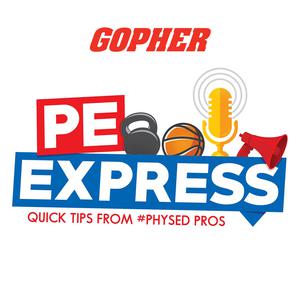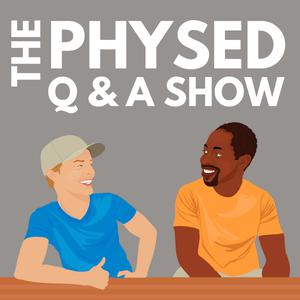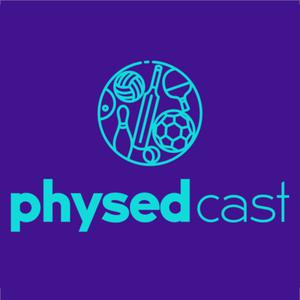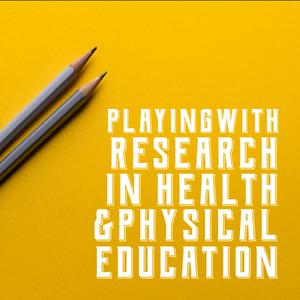
PE Express | Physical Education Quick Tips
Gopher Sport
Quick Tips from Physical Education Professionals
- 52 minutes 45 secondsBeing Born Different Helped Me See the Uniqueness of Each Student | The PE Huddle
Join Heather and Dr. Robert Pangrazi as they discuss her unique background and how it has impacted her teaching effectiveness. She came from a rural background that taught her, “to just make it work and figure it out.” Challenges from family and school leaders always took the form of, “Let’s see what you can do.” Enjoy a PE Huddle that is filled with enthusiasm, pride in our profession, and tips for getting the most out of every student.
24 October 2024, 11:46 pm - 1 hour 5 minutesUnpacking Canada's Approach to Physical Education
Understanding how physical education is taught and structured in different countries can offer insights for our programs. Often,we discover that our programs share more similarities than differences with those around the world. In fact, many of our current practices have been influenced by models from other nations, particularly those from Europe. This month’s Huddle will focus on physical education across Canada. Join us as we discuss teacher preparation, teaching methods, curriculum, and institutional practices.
9 August 2024, 1:42 pm - 57 minutes 6 secondsOptimizing the Potential of Every Student | The PE Huddle
This episode of the PE Huddle is focused on instruction that helps all students find success in physical education. Join us as we discuss topics such as rigor and differentiation, dealing with difficult student behavior, assuring equity for all students, and creating a class environment that promotes success. Our guests have over 30 years of teaching experience and will focus on offering support for teachers at all grade levels.
10 May 2024, 10:00 am - 49 minutes 15 secondsBecoming the Teacher your Students Remember | The PE Huddle
Join us for a discussion about “Becoming the Teacher your Students Remember.” This three-part podcast covers a toolbox of attitudes that you carry with you as you teach. It has a great impact on how students remember you and feel about physical education. The second part is a discussion of the Master PE Teacher video series that covers the “how to” of teaching using effective methodology. The last toolbox is filled with the Dynamic PE ASAP online curriculum which includes lesson plans, master teacher videos, formative assessment sheets, instructional signs, and fitness support signs. Join the webinar and gain access to professional support from Gopher!
12 April 2024, 1:42 pm - 56 minutes 38 secondsDr. Robert Pangrazi Answers Your Most Pressing Questions
Join the PE Huddle for a lively question and answer session. Dr. Robert Pangrazi, a Professor Emeritus at Arizona State University, and an Educational Consultant for Gopher Sport, will review and answer your questions from past podcasts in an action-packed hour. Dr. Pangrazi has had a long and illustrious career in physical education, beginning as a 5th-grade teacher and later teaching physical education for several years before becoming an ASU professor of physical education for 32 years. He has published over 60 textbooks and 125 research and professional articles.
13 October 2023, 2:16 pm - 5 minutes 15 secondsUsing AI Language Models in Physical Education | Ep. 207
The world we live in is changing rapidly thanks to the rise of AI language models, which are set to revolutionize the way we communicate and interact in countless ways. What does this mean for us as health and physical education professionals? In today's episode, we'll cover how AI language models are being used in communication education, the concerns around biases and accuracy, the role of open AI prompt engineering for improving prompt quality and the potential use of AI models and physical education.
Hi, I'm Collin Brooks, and I am an Assistant Professor of Health and Physical Education at the University of West Georgia. The voice you hear right now is not actually mine. It is an AI voice. This podcast itself was assisted by AI by using an AI script writer which I collaborated with to create this podcast, I wanted to show some of the power of AI while discussing its potential use in physical education. With that said, let's get started.
Microsoft Copilot, Google Bard, and Grammarly go are all great examples of AI language models that we can use to facilitate communication and enhance collaboration. When it comes to leading the way in developing powerful and widely used tools, open AI is undoubtedly at the forefront. These tools have the potential to help people communicate more effectively across languages and cultures. And translation models like Google Translate are already enabling real time communication without the need for a human translator. AI language models also have amazing potential for education. They can provide personalized learning experiences and assist teachers with grading and feedback. Double-checking generated text.
Being mindful of biases and using AI generated text in conjunction with other sources of information and professional expertise is critical. One popular way to use an AI language model is through open AI chat generative pre-trained transformer GPT three tool to access chat GPT language capabilities, you can visit the chat GPT page on the open AI website and click start chatting to interact with it directly in the chat window. Once in the chat window, you can ask to chat GPT questions or give prompts for it to generate text, such as creating a sentence about a specific topic or providing ideas for a new lesson plan. One of the benefits of using chat GPT is that it is free and requires no special software or hardware. However, it is important to note that it only has access to data from 2021 and earlier. If you want to save your conversations with chat GPT you can sign up for an account. You can also upgrade to chat GPT for more features, such as plugins from platforms like Zapier.
While chat GPT is a powerful tool, it should not be used as a substitute for human expertise and judgment. Health and Physical Education professionals can use chat GPT to assist in their work, but should still rely on their own knowledge and experience. It is also important to critically evaluate chat GPS responses for accuracy and appropriateness. In the following sections, we will discuss how Chat GPT can help create quality learning content and lesson plans, specifically through prompt engineering. Effective prompt engineering is the key to unlocking the full potential of these models. Prompts are specific and precise instructions that enable the AI language model to generate high-quality responses that are aligned with the user's goals. The quality and specificity of prompts directly impact the AI language model's output quality, so good prompt design is critical. Asking chat GPT for information about a particular topic with a vague and open-ended prompt like what can you tell me about topic X might not yield accurate results. Instead, it's better to use a specific and well-structured prompt that clearly defines the topic and what information is being requested. For example, a prompt like what are some effective teaching strategies to help students manage stress and anxiety during the COVID-19 pandemic is effective because it is specific provides a clear request for information, and is easy to understand. This helps chat GPT generate a relevant and helpful response. Physical education professionals can benefit greatly from AI language models, which can assist or act as a collaborator for teachers create engaging and effective learning content, and even help create tailored assessments and rubrics for grading. Nevertheless, it is crucial to approach these models with caution and careful consideration.
As the accuracy and appropriateness of the generated text can vary widely. I encourage you to check out chat GPT and begin learning effective prompt engineering skills and see the various ways it can provide you help in your workflow and enhance student learning. While integrating chat GPT into educational platforms as possible, it should be executed with caution and attentiveness towards student learning. It is essential to adhere to best practices such as creating content that aligns with academic standards, promotes inclusivity, is accessible, and resonates with students of diverse backgrounds and abilities. Adopting a student-first approach during the creation process can guide businesses and creators in a direction that will ultimately enhance student learning and experiences as long as they are mindful and deliberate.
Thanks for listening to today's episode, where we explored how AI language models can be helpful in physical education while also being mindful of potential biases and accuracy concerns don't forget to subscribe for more insights in the future
15 May 2023, 7:30 pm - 58 minutes 3 secondsThe PE Huddle | Effective Teaching Practices that Groom Students for SuccessJoin the PE Huddle with two outstanding teachers who have had over 20 years of success. How they manage and teach students to reach their full potential will be discussed from many different angles. Both teachers have experience with students in many settings and have learned the fundamentals of “assuring students learn.” In addition, learn how they challenge themselves to improve and grow and maintain their desire to be the best teachers they can be. Alvin Mariteragi has been an educator for 24 years in Hawaii. His experiences in teaching have taken him from Pre K, Elementary, Middle School, High School, and to the University level. Physical Education, Health Education, Adaptive PE, & Weight training are his main focus. He is also the Head Strength and Conditioning Coach who trains and services all the athletic sports at Kahuku High School. In the midst of this he still finds time to teach at Brigham Young University Hawaii as an adjunct faculty member. He is a firm believer that managing students is the key to unlocking their potential to learn.
Brian Hull taught secondary physical education for 10 years in Denver, Colorado (in Denver Public Schools). All of Brian’s experiences have been in high needs Title 1 schools. In 2018, Brian received the SHAPE Colorado High School Teacher of the Year award. Additionally, in 2020, Brian was named the SHAPE America National High School Teacher of the Year. In July 2021, Brian transitioned out of teaching and joined the SPARK and Gopher Sport teams. Brian firmly believes in the “education” aspect of physical education.
12 May 2023, 1:00 pm - 5 minutes 36 secondsFive Tips to Refuel and Energize This Summer! | Ep. 206Welcome to the P E Express Podcast, powered by Gopher! As the school year winds down and summer approaches, we know it can be tough to balance getting everything done with making the most of your time off. That's why we're here to help with tips and strategies to recharge and push yourself during your summer break. This article was written by Matthew Bassett. Matthew has been teaching Physical Education since 2001. He is a Nationally Board Certified and an adjunct professor. He is active in both the Elementary Physical Education Workshop and CAHPERD. You can find him on Twitter at phys ed apps. Don't miss an episode and be sure to subscribe to stay updated! Welcome to today's episode where we'll be discussing 5 tips to help you prepare for the upcoming school year. Let's dive right in! Number one on our list is to learn something new. Take a class. Read an educational book. Watch a webinar. Do something that is not work/subject related. Disconnect from your teaching brain by learning something new. Put yourself in an uncomfortable situation to learn something new that you do not already know. You will enjoy the change of pace and your brain will change as the result of this challenge. Next up, number 2, seek out professional development opportunities. Summer is a great time for you to learn something inside of your profession or subject. Going to a workshop, conference, or work-related webinar is a great way to hone your teaching skills. My favorite is the K through 8 Elementary Physical Education Workshop or E PEW. Not only do I get to learn from some of the best #physed teachers around but I’m immersed into the experience. I’m able to be around like-minded individuals from the time I wake up until the time I go to sleep. We eat, learn and play together. Sometimes the best interactions happen when a small group goes out to get some ice cream during the evening. These interactions drive me. I set myself up for the best possible start for the coming school year when I join these experiences. Number three is all about getting some rest. During the summer I’m able to rest a lot more. The first few days are normally spent taking a lot of naps and sleeping in. I love being able to get up a little later during the summer and not before the sun gets up. I am also able to spend some time sitting on the couch binge watching a TV show or catching a movie. I can catch up on Star Trek or rewatch Star Wars. I struggle with getting rest during the school year as I seem to be always doing something from teaching phys ed to one of my college classes. The summer I find the change of pace difficult but necessary. I use the summer to let my aging body recover a bit. I also make it a priority to get away. My kids are getting older and only have time for a few more family adventures. Some years we stay more local and experience a lot of day trips. Other years we plan a big trip across the country. Travel helps me to learn and grow but also gives me time to unwind and disconnect from my computer. I also try to get away with my wife for a few days. The time to reconnect is important as our daily life seems to be work and shuffling the kids around from point A to point B. Ideally, if I had the funds and time, I would attempt to get away for at least a few days after I get out for the summer and also a trip before I have to go back. I find myself getting more anxious as I get closer to returning to work and having the time away helps to minimize those feelings. Our fourth tip is to complete any necessary time-consuming tasks ahead of time. Spend some time during the summer completing those time-consuming tasks that eat up your life when you start teaching again. Maybe you need to revamp your curriculum? Maybe you wanted to overhaul your roll sheets? Maybe you need to create new Plicker cards? Maybe you want to make new peer assessment worksheets? Take the time to update your playlists so they are ready to go before your first class. These are things that aren’t difficult but take time. Having these items off your to do list as you start back up frees up time to work on something else. Last but not least, take some time to reflect on the previous school year. Maybe the most important part of the summer, REFLECTION! If you want to be a great educator, you need to think about what has happened during the previous school year. Reflection should probably come sooner rather than later during the summer but it can occur at any point. What can you do to make yourself better? What worked this school year? What didn’t work? How can you deal with conflict/difficult situations or off task students better than you did last year. What if you change the order of your units? What if you developed a new team building activity to mix it up for you? Thinking about where you have been can help you take a different path for the future. Teaching the exact same thing, the exact same way will just get you to be bored. After 22 years of service, I’m still tinkering with the things that I do on a daily basis. At the core of this is reflection. Without reflection I would be repeating the same mistakes year after year after year. In today's episode, we discussed some key ways to improve yourself, professionally and academically through learning, resting, and finishing important tasks, including taking time to reflect on the past academic year. If you enjoyed today's episode, don't forget to subscribe for more tips and teaching strategies to help you become a better P E professional. Thanks for listening, we'll see you next time on the P E express podcast, powered by Gopher, your resource for all things physical education.8 May 2023, 4:23 pm
- 3 minutes 40 seconds6 Reasons to Inventory your Equipment | Ep. 205
Keeping an inventory equipment list and sharing it with your principal demonstrates that you value and care for your equipment. It also clearly defines your equipment needs and helps you share a clear and consistent vision for your PE program.
If you haven’t seen it yet, take a look at the PE Equipment Calculator. This is a free resource that gives you an essential inventory list that you can use to monitor your equipment needs each year. After you complete your inventory, this calculator matches your program’s equipment with SHAPE America National Standards and Outcomes and calculates which outcomes can be taught with the equipment available. Share this calculator with your principal or PE leader to strengthen your ask for additional funding and equipment.
1 May 2023, 2:31 pm - 54 minutes 55 secondsThe PE Huddle: Making a Difference - Artie Kamiya’s Long and Storied CareerMaking a Difference – Artie Kamiya’s Long and Storied Career Artie Kamiya has held a wide variety of jobs and titles over his career. First of all, he was Mr. Kamiya, elementary physical education teacher. Then he was demoted into administration and was Artie Kamiya, Physical Education Consultant for the NC Department of Public Instruction. Then demoted further to the Chief Consultant for K-12 Healthful Living for the same state agency. In 2001, he left to work with Wake County Public Schools as the Senior Administrator for Health & PE. In 2005, he retired from public service having put in enough time to earn his 30 year pin. From 2005 – 2018, he worked for Great Activities Publishing Company. Finally, after messing everything up to the best of his ability, he became the Executive Director of NC SHAPE where he gets to work with some of the most amazing K-12 health and physical education teachers he knows.10 February 2023, 11:00 am
- 1 hour 2 minutesMidyear Corrections: Little Things that Make a Big Difference
Tune into the PE Huddle to hear about how to make personal changes in your teaching practice to make your profession personally rewarding. Topics such as emotional and physical safety, off-task behavior, modeling desired behavior, and efficient planning are just some of the topics to be discussed. As one of our speakers puts it, “The art of a tough few weeks of consistency to create a well-oiled machine” is a good place to start.
Holly Aungst is a Professor and Administrator in the Health Sciences Department at Northern Arizona University. She prepares teacher candidates to deliver appropriate instruction that is physically and emotionally safe for all learners. With nearly 15 years’ experience, Holly shares her expertise often by presenting at state and national conferences.
Theresa Freas has taught Health, Physical Education and Yoga for 24 years at Coconino High School in Flagstaff AZ, (her Alma Mater). Theresa has served as Department Chair for 15 years, was a Link Crew Coordinator for 15 years and coordinated the Alternative to Suspension program. Theresa earned her bachelor’s degree in Physical Education, Health Education in addition to Athletic Training at Southern Utah University.
23 January 2023, 5:10 pm - More Episodes? Get the App
Your feedback is valuable to us. Should you encounter any bugs, glitches, lack of functionality or other problems, please email us on [email protected] or join Moon.FM Telegram Group where you can talk directly to the dev team who are happy to answer any queries.
 The #PhysEd Show
The #PhysEd Show
 The PhysEd Q & A Show
The PhysEd Q & A Show
 PhysEdcast
PhysEdcast
 Playing with Research in Health and Physical Education
Playing with Research in Health and Physical Education